|
Youth Revived through Adamo’s Singing Voice (No.35)
12th of November 2013
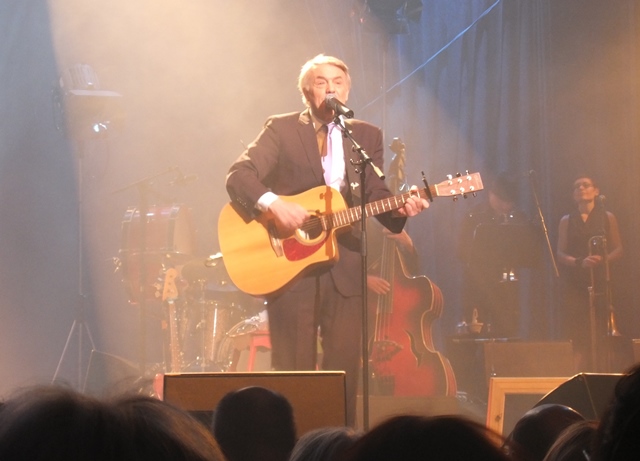 “Tombe la neige” by Salvatore Adamo is an unforgettable masterpiece for people of my generation and is even part of the memories of my adolescence. There must have been many young Japanese at the time who shed tears of sorrow listening to this song when they got their hearts broken. Mr. Adamo (many Japanese think he is French or Italian, but he is in fact Belgian) had many hits such as “Sans Toi Mamie” and “Inch Allah”. In addition to this, he loves Japan, having performed more than 30 times in Japan. As he sings some songs in Japanese, he is familiar to Japanese people. Adamo celebrated his 70th birthday (and his 50th anniversary as a singer) this month. The other night, a concert for his birthday was held in a theatre in Brussels and the venue was filled with mostly elderly Adamo fans. While listening to many famous tunes at this concert, I felt uncharacteristically very emotional, remembering “the days of youth gone by”. Adamo’s husky voice that I had heard in my student days startled me and even now it sticks in my head. It is said that “Songs change with the times and the times change with the songs”, but on that night I felt that each person’s life is surrounded by hit songs of his or her era. “Tombe la neige” by Salvatore Adamo is an unforgettable masterpiece for people of my generation and is even part of the memories of my adolescence. There must have been many young Japanese at the time who shed tears of sorrow listening to this song when they got their hearts broken. Mr. Adamo (many Japanese think he is French or Italian, but he is in fact Belgian) had many hits such as “Sans Toi Mamie” and “Inch Allah”. In addition to this, he loves Japan, having performed more than 30 times in Japan. As he sings some songs in Japanese, he is familiar to Japanese people. Adamo celebrated his 70th birthday (and his 50th anniversary as a singer) this month. The other night, a concert for his birthday was held in a theatre in Brussels and the venue was filled with mostly elderly Adamo fans. While listening to many famous tunes at this concert, I felt uncharacteristically very emotional, remembering “the days of youth gone by”. Adamo’s husky voice that I had heard in my student days startled me and even now it sticks in my head. It is said that “Songs change with the times and the times change with the songs”, but on that night I felt that each person’s life is surrounded by hit songs of his or her era.
< BJA to Celebrate its 50th Anniversary >
Three days ago on Saturday night, a Gala Dinner to celebrate the 50th anniversary of the foundation of the BJA (Belgium-Japan Association) was held at the Colonial Palace on the outskirts of Brussels. From the Belgian Royal Family, their Royal Highnesses Prince Laurent and Princess Claire attended the celebration. The Belgian Royal household highly appreciated the activities of the BJA over half a century and the BJA was honoured with the “Royal” title. The association, of which most members are related to Belgian and Japanese companies, organizes many convivial activities to deepen the relationship between both countries and close to 260 members in formal dress attended the dinner that night. As mentioned in Ambassador’s Chat No. 7, the forerunner of the BJA dates back to the beginning of the 20th century. This history of a circle of friendship and goodwill expanded by the hands of businessmen of both countries deserves special mention indeed.
< Opening Ceremony of the Commemorative Events on the Occasion of the First World War Centenary in the Walloon Region >
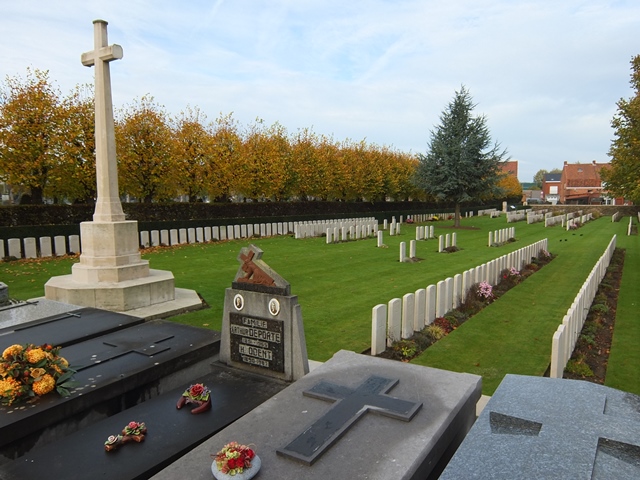 About one week ago on an evening, I attended a ceremony in Namur (located 65 km in the south-east of Brussels, giving the start for a series of events to commemorate the First World War (1914-1918) in the Walloon region (French-speaking). Several hundred people, amongst whom Mr Rudy Demotte, Minister-President of Wallonia, attended the ceremony at a theatre in the city centre. They recalled the horrors of mankind’s First World War in which Belgium was one of the main battlefields and mourned the souls of the victims, which are said to be more than 20 million including civilians worldwide. In 1914, the German army invaded neutral Belgium, occupied most of the national territory and marched up to eastern and northern France. Opposing this, the British Commonwealth Forces of Great Britain, Canada and Australia launched a counterattack in cooperation with the French army. In the end, the US joined the war on a large scale and made Germany surrender in 1918. Japan declared war to Germany in August 1914 based on the Anglo-Japanese Alliance and deployed for war on land with Germany in the east of China and combatted the German navy for the purpose of guarding and rescuing British and French merchant ships in the Indian Ocean and in the Mediterranean Sea as well. During this period, a large number of Japanese soldiers fell victim to the war. At the ceremony that night, the Ambassador of Germany to Belgium had also been invited, in addition to the Ambassadors of France and the United Kingdom to Belgium. All of them spoke words of grief. I guess that the ceremony was definitely not comfortable for the Ambassador of Germany, who is also a colleague of mine, but nevertheless he delivered a great speech. He spoke reflectively from the point of the aggressor and even talked about victims amongst his relatives. He further expressed Germany’s determination to promote the unification of Europe through friendship with neighbouring countries as a priority. Though many commemorative events will take place throughout Belgium in the next four years, I can imagine all too well the distress of the German representatives that continue to attend these events. About one week ago on an evening, I attended a ceremony in Namur (located 65 km in the south-east of Brussels, giving the start for a series of events to commemorate the First World War (1914-1918) in the Walloon region (French-speaking). Several hundred people, amongst whom Mr Rudy Demotte, Minister-President of Wallonia, attended the ceremony at a theatre in the city centre. They recalled the horrors of mankind’s First World War in which Belgium was one of the main battlefields and mourned the souls of the victims, which are said to be more than 20 million including civilians worldwide. In 1914, the German army invaded neutral Belgium, occupied most of the national territory and marched up to eastern and northern France. Opposing this, the British Commonwealth Forces of Great Britain, Canada and Australia launched a counterattack in cooperation with the French army. In the end, the US joined the war on a large scale and made Germany surrender in 1918. Japan declared war to Germany in August 1914 based on the Anglo-Japanese Alliance and deployed for war on land with Germany in the east of China and combatted the German navy for the purpose of guarding and rescuing British and French merchant ships in the Indian Ocean and in the Mediterranean Sea as well. During this period, a large number of Japanese soldiers fell victim to the war. At the ceremony that night, the Ambassador of Germany to Belgium had also been invited, in addition to the Ambassadors of France and the United Kingdom to Belgium. All of them spoke words of grief. I guess that the ceremony was definitely not comfortable for the Ambassador of Germany, who is also a colleague of mine, but nevertheless he delivered a great speech. He spoke reflectively from the point of the aggressor and even talked about victims amongst his relatives. He further expressed Germany’s determination to promote the unification of Europe through friendship with neighbouring countries as a priority. Though many commemorative events will take place throughout Belgium in the next four years, I can imagine all too well the distress of the German representatives that continue to attend these events.
< Toyota Technical Centre >
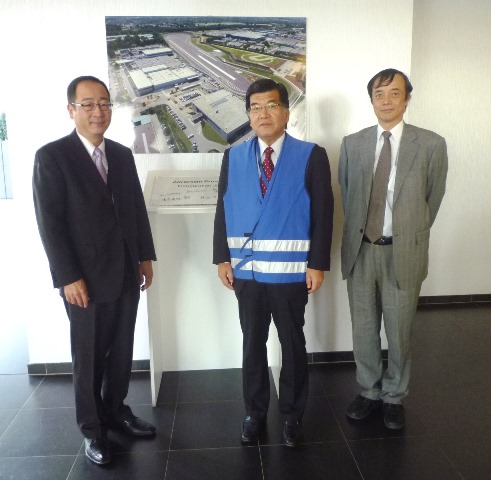 End of last month, I paid a visit to the Technical Centre of Toyota in Zaventem (suburbs of Brussels in the northeast). In this centre, surveys and studies are conducted on Toyota cars that are sold in Europe and I was able to see the elaborate work from design research to performance tests. There are about 800 employees, of which nearly 150 people are dispatched from Japan. The company has the highest ratio of Japanese among the Japanese companies operating in Belgium. What’s interesting about cars is that the European and Japanese taste in cars is very different. Most of the Japanese models of Toyota cars are not always popular in Europe, so it is necessary to introduce original European models. Take one seat for example, while the Japanese have a small difference in height, the difference in height of Europeans is big, so an adjuster to adjust the height of the driver’s seat is essential. Toyota boasts an overwhelming share of nearly 50% in Japan and a share of 14-15% is reached in the United States, but in Europe, Toyota’s share is not higher than 4-5% (of which two thirds are made in Europe). I know many people among my Belgian friends that love Toyota, but looking at the share, I think there is still room to grow. I would like that as many Europeans as possible get to know the merits of Toyota cars and Japanese cars. End of last month, I paid a visit to the Technical Centre of Toyota in Zaventem (suburbs of Brussels in the northeast). In this centre, surveys and studies are conducted on Toyota cars that are sold in Europe and I was able to see the elaborate work from design research to performance tests. There are about 800 employees, of which nearly 150 people are dispatched from Japan. The company has the highest ratio of Japanese among the Japanese companies operating in Belgium. What’s interesting about cars is that the European and Japanese taste in cars is very different. Most of the Japanese models of Toyota cars are not always popular in Europe, so it is necessary to introduce original European models. Take one seat for example, while the Japanese have a small difference in height, the difference in height of Europeans is big, so an adjuster to adjust the height of the driver’s seat is essential. Toyota boasts an overwhelming share of nearly 50% in Japan and a share of 14-15% is reached in the United States, but in Europe, Toyota’s share is not higher than 4-5% (of which two thirds are made in Europe). I know many people among my Belgian friends that love Toyota, but looking at the share, I think there is still room to grow. I would like that as many Europeans as possible get to know the merits of Toyota cars and Japanese cars.
< The Catholic University of Leuven’s (KUL) Japan Week >
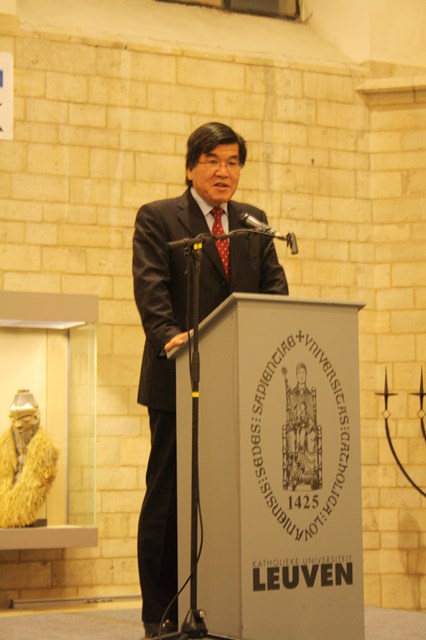 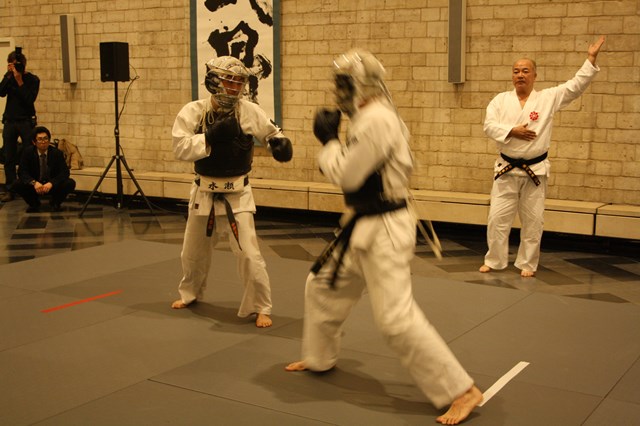 Last week, the “Japan Week” was held at the Catholic University of Leuven (KUL) where I had the opportunity to give a speech at the opening ceremony on the first day. This cultural event is held in collaboration with the Kansai University in Japan every two years and took place now for the 4th time. Several professors such as Mr. Eiji Yoshida, Vice-President, attended the ceremony as guests of honour. Prior to the ceremony, a symposium on “Pop culture and Japanese culture” was held and after the ceremony, students of the Kansai University gave a demonstration of Nippon Kempo, Japanese Martial Arts. Kansai University is a private university with its main campus in Suita-City in Osaka. Though founded in 1886 as a law school, it is a general university with about 30.000 students at present. Kansai University concluded an agreement with the Catholic University of Leuven (KUL) in 1986, the year of the 100th anniversary of the foundation of Kansai University. In addition to many exchanges of professors and researchers, also international student exchange takes place. The “Japan-EU Research Centre” was founded in Kansai University in 2006 and it is this centre that organizes the “Japan Week” in collaboration with the Japanese Studies Department of the Catholic University of Leuven (KUL). A good number of universities have international exchange and cooperation programs, but in many cases these programs become a dead letter, so it is admirable that the actual exchange activities between the Catholic University of Leuven (KUL) and Kansai University are continually developing. Last week, the “Japan Week” was held at the Catholic University of Leuven (KUL) where I had the opportunity to give a speech at the opening ceremony on the first day. This cultural event is held in collaboration with the Kansai University in Japan every two years and took place now for the 4th time. Several professors such as Mr. Eiji Yoshida, Vice-President, attended the ceremony as guests of honour. Prior to the ceremony, a symposium on “Pop culture and Japanese culture” was held and after the ceremony, students of the Kansai University gave a demonstration of Nippon Kempo, Japanese Martial Arts. Kansai University is a private university with its main campus in Suita-City in Osaka. Though founded in 1886 as a law school, it is a general university with about 30.000 students at present. Kansai University concluded an agreement with the Catholic University of Leuven (KUL) in 1986, the year of the 100th anniversary of the foundation of Kansai University. In addition to many exchanges of professors and researchers, also international student exchange takes place. The “Japan-EU Research Centre” was founded in Kansai University in 2006 and it is this centre that organizes the “Japan Week” in collaboration with the Japanese Studies Department of the Catholic University of Leuven (KUL). A good number of universities have international exchange and cooperation programs, but in many cases these programs become a dead letter, so it is admirable that the actual exchange activities between the Catholic University of Leuven (KUL) and Kansai University are continually developing.
< A School of Music in Mons >
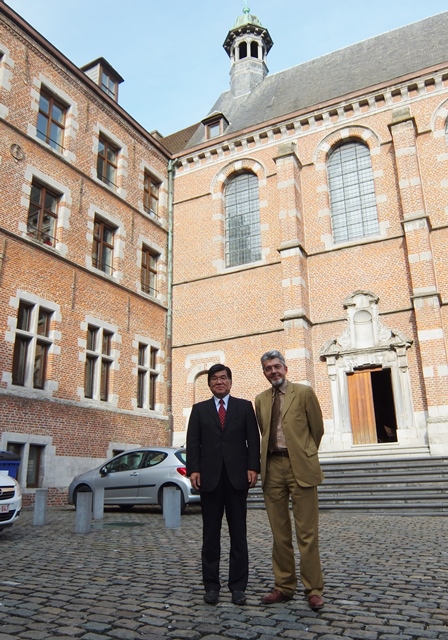 About 10 days ago, I visited the Conservatoire in Mons where I observed the current state of music education in a provincial city in Belgium. This school was founded in 1948 and was united with other schools of arts and theatre at the beginning of last year. Now it exists as the Music Department of the School of Arts of Mons (ARTS2). Recently, I got acquainted by chance with the Director, Mr. Michel Stockhem, and was invited to visit the school. The school building that was built as a boarding school for girls (couvent) at the beginning of the 17th century looked ancient and has been used already as a local music school since the beginning of the 19th century. It is a small school with 250 students at the Conservatoire and 650 students with the departments of theatre and arts combined. Director Stockhem had contacted one Japanese professor (piano department) and two Japanese female students for my visit and we were able to talk for a while. I also met a Japanese teacher of bookbinding, who’s working close to the School of Arts. In the case of Belgium, there are besides the two public conservatoires in the capital Brussels, also music schools in Ghent, Liège and Antwerp. The school in Mons is the 6th school and is the most recent one. Even if only a few people, it is amazing that there even are Japanese teachers and students in such a local town. About 10 days ago, I visited the Conservatoire in Mons where I observed the current state of music education in a provincial city in Belgium. This school was founded in 1948 and was united with other schools of arts and theatre at the beginning of last year. Now it exists as the Music Department of the School of Arts of Mons (ARTS2). Recently, I got acquainted by chance with the Director, Mr. Michel Stockhem, and was invited to visit the school. The school building that was built as a boarding school for girls (couvent) at the beginning of the 17th century looked ancient and has been used already as a local music school since the beginning of the 19th century. It is a small school with 250 students at the Conservatoire and 650 students with the departments of theatre and arts combined. Director Stockhem had contacted one Japanese professor (piano department) and two Japanese female students for my visit and we were able to talk for a while. I also met a Japanese teacher of bookbinding, who’s working close to the School of Arts. In the case of Belgium, there are besides the two public conservatoires in the capital Brussels, also music schools in Ghent, Liège and Antwerp. The school in Mons is the 6th school and is the most recent one. Even if only a few people, it is amazing that there even are Japanese teachers and students in such a local town.
< The Wild Enthusiasm of the Third Japan Expo >
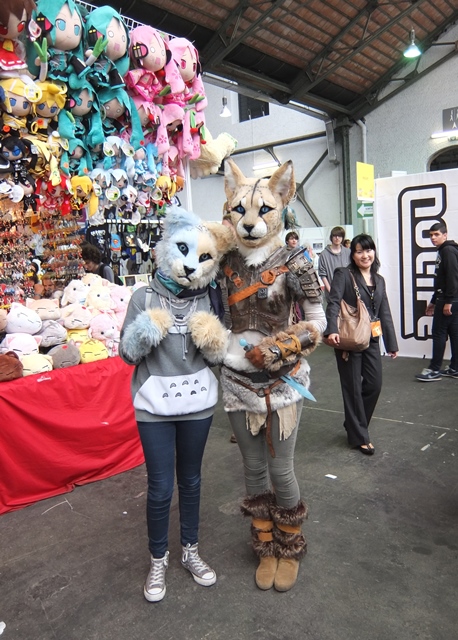 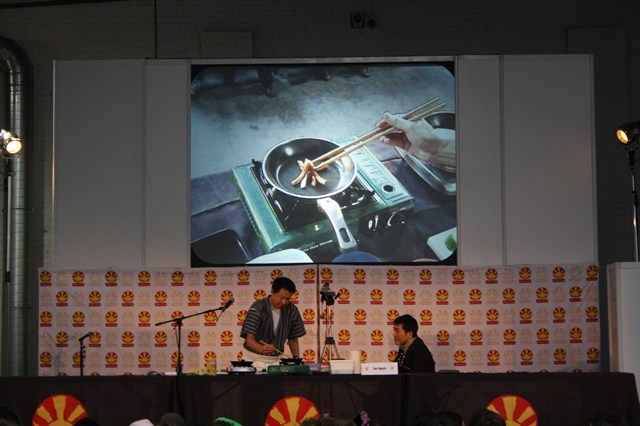 The beginning of this month, “Japan Expo”, which should be called a festival of Japanese pop culture, was held in a huge exhibition hall in the centre of Brussels. This great cultural event is organized by a private company in France and was held this year for the third time in Brussels (see Ambassador’s Chat No. 1). This event has been held in Paris since more than 10 years and attracted this year more than 230.000 visitors, spread over 4 days. Brussels has not reached the scale of Paris yet, but judging from what I heard on the first day when I visited the venue, a total of 30.000 visitors was to be expected over 3 days. Similar to last year, this year as well, although anything related to Japanese culture could be found there, what attracted most of the Belgian young people, was again the cosplay show. This show took place in a special large hall where a several hundred people can gather, but it was so popular that people had to stand. Outside of this special hall as well, young people dressed as characters from manga, anime or PC games strutted around and I also pointed my camera at them unintentionally. This time, our Embassy made slightly elaborate plans and organized, in addition to an initiation into the Japanese language and origami workshops, also a demonstration of the Japanese lunch box preparation and a demonstration with commentary of the therapeutic robot “Paro”. I think these were received very well. Following Paris and Brussels, “Japan Expo” was held on the west coast of the United States as well from this year on and has become an event that spans both sides of the Atlantic. The event was greatly covered by the Belgian media and I realized that Japanese pop culture is accepted universally. The beginning of this month, “Japan Expo”, which should be called a festival of Japanese pop culture, was held in a huge exhibition hall in the centre of Brussels. This great cultural event is organized by a private company in France and was held this year for the third time in Brussels (see Ambassador’s Chat No. 1). This event has been held in Paris since more than 10 years and attracted this year more than 230.000 visitors, spread over 4 days. Brussels has not reached the scale of Paris yet, but judging from what I heard on the first day when I visited the venue, a total of 30.000 visitors was to be expected over 3 days. Similar to last year, this year as well, although anything related to Japanese culture could be found there, what attracted most of the Belgian young people, was again the cosplay show. This show took place in a special large hall where a several hundred people can gather, but it was so popular that people had to stand. Outside of this special hall as well, young people dressed as characters from manga, anime or PC games strutted around and I also pointed my camera at them unintentionally. This time, our Embassy made slightly elaborate plans and organized, in addition to an initiation into the Japanese language and origami workshops, also a demonstration of the Japanese lunch box preparation and a demonstration with commentary of the therapeutic robot “Paro”. I think these were received very well. Following Paris and Brussels, “Japan Expo” was held on the west coast of the United States as well from this year on and has become an event that spans both sides of the Atlantic. The event was greatly covered by the Belgian media and I realized that Japanese pop culture is accepted universally.
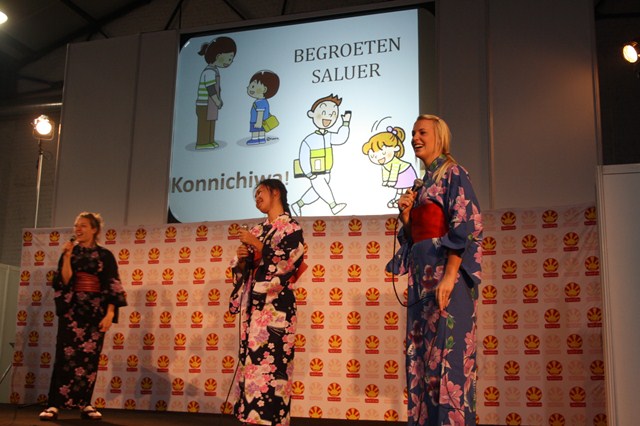 
|

